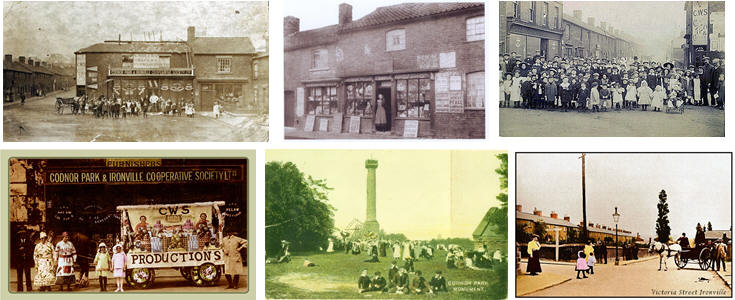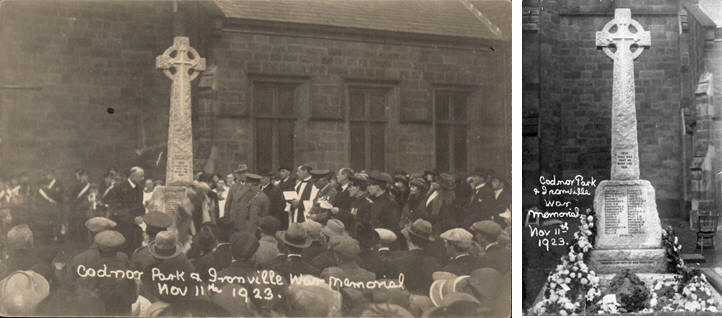
Potted
History – Ironville &
Codnor Park in a nutshell
History – Ironville & Codnor Park in a
nutshell
Ironville is
possibly Derbyshire’s best example of a mid-nineteenth century model village.
The village itself was mainly created between 1834 and 1860 by the Butterley
Company to house its iron workers. The model village won much national acclaim,
with its large gardens, a rural setting well away from the ironworks and the
overall spacious layout compared with other industrial villages. The physical
and spiritual welfare of the employees of the Company was reflected not only in
the provision of a church and a school by the Company, but also with the
provision of a complete range of public services for the village. These included
its own gas and water works, a Mechanics' Institute containing 'an artisans'
library' and swimming bath. Nearby, but still within the parish of Ironville is
Codnor Park formally an ancient Deer Park. At
the historically renowned Codnor Park Iron Works (demolished in the 1970’s and
now landscaped and planted with native trees), cannonballs were made for
Waterloo, armor plate was made for the very first iron-hulled warships such as
The Warrior
& The Black Prince (circa 1861).
During World War II the works also
produced sterns for 57 “Loch” class frigates, and 51 large bridges, each with a
150-foot span, which were used for crossing the Rhine and Italian rivers, in
addition the company manufactured tracks for Churchill and Cromwell tanks as
well as many other important products for the war effort.
The first
houses in Codnor Park actually built by the Butterley Company in 1802 for
workers at the newly built Lime Works.
The row of houses was originally called Measham Row (later Lime Kiln Row)
and probably reflects where these workers came from.
They would all have walked there or hitched a ride on barges passing
along the canal system. This would
also apply to all the workers who came to live there in the period 1834 to 1860.
Many walked from Wales just to be employed there, not being able to
afford train fares etc. Just imagine
- a house and a job! They must have
thought they were dreaming or heading for the land of plenty?
Just imagine
what it was like to live in Ironville
more than 100 years ago.
A thriving community:

The ironworks
at Codnor Park formed part of the famous Butterley Company. During the 19th
century the Company became a thriving success. In 1862 there were seven furnaces
at Butterley and Codnor Park which produced one-fifth of the total output of
iron in Derbyshire. Later in the 19th century the production of ironstone
declined locally, but the Company still remained a major force in the iron
industry. It was heavily involved in the expansion of the railway industry, by
the manufacture of track and wagons at its foundry and engineering works, and
the Butterley Company was famously used for the huge arched roof of St Pancras
Station in London. Throughout its history the Company was heavily involved with
the production of bridges, heavy structural steelwork, mining equipment and
machinery, presses, castings and overhead cranes.
The
development of Codnor Park and Ironville is due to the formation of the
Butterley Company and the opening of the Cromford Canal.
Before the
Codnor Park iron works had been constructed, coal and iron stone had been mined
in the area for hundreds of years.
Records go back to the De Grey family having coal mines in the area in
the fifteenth century. In 1599
Thomas Shorter married Elizabeth Bradway, in Heanor Parish Church.
Thomas’s address was given as living “at Codnor Park by the Furnace.”
Before Ironville Parish Church was constructed Codnor Park was an 'extra
parochial liberty' referring to the fact that the area did not at that time come
under any parish. Couples in those
days had to travel as far as Heanor, Eastwood and Alfreton to get married.
Codnor Park was once part of the Manor
and Castle of Codnor and was mentioned in Domesday Book.
Close to the
village is one of only two medieval castles retaining its original medieval
architecture in the whole of the county of Derbyshire.
Codnor Castle has a very rich history and the castle site dates back to
the 11th century. Codnor
castle was the home and power base to one of medieval England’s most powerful
family's for 300 years; the De Grey family or otherwise known as the Baron's
Grey of Codnor. This medieval fortress was once grand enough to play host to
royal visits.
When Channel
4’s Time Team visited they quite
literally struck gold. Excavations at Codnor Castle in Derbyshire unearthed a
gold coin which presenter Tony Robinson said was one of the most valuable single
items ever found on Time Team. Their
discoveries revealed far more than anyone ever expected. In the bottom of Codnor
Castle’s moat they found a Gold Noble coin which dates back to the time of Henry
V and the Battle of Agincourt. Their excavations also uncovered the remains of a
massive round tower and one of the first drawbridges ever discovered in the
programme’s 15 year history.
The village in
the nineteenth century boasted its very own brewery, a pottery and a brick
works. In the twentieth century
there was for a time, an oil well producing 400 gallons of oil per day, (1921).
The
parishioners of Codnor Park and Ironville can claim to possess one of the most
substantial and beautiful monuments to World War I in the county. The unveiling
and dedication ceremony was held on 16th November 1923.
The engraving and erection of the
memorial was carried out by an ex-Service man, Mr. E. Cope, of Riddings.
The foundation, which measures 8 feet by 7 feet 6 inches, has been laid
by the Butterley Company; also the paving from the gateway to the monument.

The village is
set within excellent countryside surroundings with many wonderful signposted
walks and benefits from being only ten minutes from the local town centres of
Alfreton and Ripley.
Codnor Park
Reservoir, built originally to top up the canal is a popular spot for walking
and fishing, with good access for disabled anglers,
also a haven for a variety
of birdlife.
Less than two
miles to the west of the reservoir is Swanick Junction part of the Midland
Railway Trust which commemorates one of the major railway companies of its time.
It has a superb collection of steam and diesel locomotives which may be seen
powering trains on the line or on display in the museum.
The Golden Valley Light Railway (GVLR) and Butterley Park Miniature
Railway are based here too.
To go back to Bridge History Click HERE